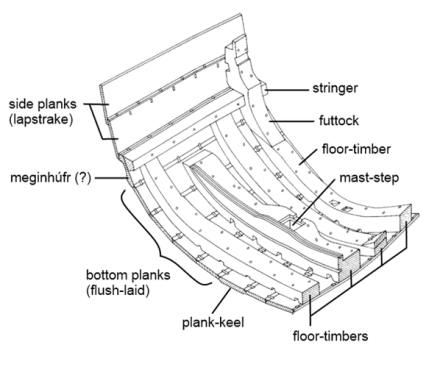History
The Kollerup wreck or "Kollerup Cog" was discovered 1978 in a silted up area of Vigsø Bay at Kollerup Strand, some 125 km southwest of Skagen as the crow flies. Although it was built of oak which was cut in southern Jutland (like the Skagen ship), some parts of the cargo indicate that it must have called at a North Sea port before founderin, probably in the Low Countries. This is indicated by pottery from Schinveld and Blussum, as well as large quantities of slates from the Rhineland.
The timber was sourced in Jutland (Denmark) and was cut around 1150. The wreck has a number of features similar to the "Bremen Cog" (1380), which has been regarded as the prime example for a high medieval Hanseatic cog (though this way of thinking about cogs is discarded by some researchers, see the entry for the Bremen Cog for this). For this reason the Kollerup wreck has been often described as "missing link" in the early development of cogs.
The Kollerup wreck is often associated with the Ummeland route (the route to the Baltic along the Danish coast), which was often avoided: the cape of Skagen was dreaded because of its mighty cross-seas and currents. This may also be reflected in the "Ummeland privilege", which implied the right to take a safer sea route along the Norwegian coast rather than the Danish Skagerrak coast. The site of the wreck close to where the Sløjkanalen would have entered into the Skagerrak also points to a possible use of the Limfjord passage. It is easily imaginable that the ship's crew miscalculated the right approach to the canal's entrance, causing the ship to run aground, or that the waterway had already silted up to unexpected levels and thus could not be traversed. Since it is not known exactly when the Limfjord's western access silted up, this has to remain a hypothesis (first formulated by the author of this entry, cf. Zwick 2017).

Description
Many of its characteristics are in line with the Bremen-type, like the use of tangentially cut planks, the straight fore and aft stem, the stern-rudder, the use of sintels (iron fasteners holding slats placed over the seems in place), the use of moss for caulking, and bent nails. All these criteria have been connected to the bottom-based shipbuilding tradition (a way of constructing ships that began with building the full bottom of the vessel) that the Bremen-type belongs to, which is commonly associated with the historical "cog" type.
Nonetheless, the ship has a significant amount of criteria that do not fit this typology. These are the narrow hull, the unusually forward position of the mast–step in the foremost third of the ship, the mast's position in a floor-timber rather than a keelson and the special nails with which the plank shafts were fastened (featuring 4 pegs at the bottom side of the head of the nail).
Another interesting anomaly is the reversed L-shaped strake at the transition between the lapstrake and carvel planking. This is the fifth strake, which is reminiscient of an old Norse feature known as meginhúfr, literally “strong strake”, which supports the upper end of the frame on which the knees rest. The meginhúfr traditionally facilitated the transition from bottom to side planking in Viking Age vessels, strengthening the vessel laterally and in some cases jutting out like a cornice at the waterline.

| Length | 69 feet (21 m) |
|---|---|
| Width | 14 ¾ feet (4.5 m) |
Status
The wreck is curated by the Thisted Museum.
Since the wreck is considered to be an archetype of an "early cog", a ship type that has been commonly associated with the Hanseatic League, a (near) full-scale reconstruction was made by a movie set production company for the first room of the Europäisches Hansemuseum (European Hansemuseum) in Lübeck. This shows the arrival of German merchants in cogs in 1191 in the lower reaches of the Neva River (in Russia) to conclude a treaty for the establishment of a trading post in Novgorod, which is commonly regarded as the foundation date of the Hanseatic League.
References
- Bill, J., Poulsen,B., Rieck, F., Ventegodt, O. (1997).
Dansk søfartshistorie indtil 1588.
Copenhagen. - Crumlin-Pedersen, O. (1985).
Cargo Ships of Northern Europe 800-1300.
In: A. E. Herteig (ed.), Conference on Waterfront Archaeology in Northern European Towns 2.
pp 83-93. - Crumlin-Pedersen, O. (2010).
Archaeology and the Sea in Scandinavia and Britain (= Maritime Culture of the North 3).
Roskilde. - Daly, A. (2007).
Timber, Trade and Tree-rings. A dendrochronological analysis of structural oak timber in Northern Europe, c. AD 1000 to c. AD 1650 (= Dissertation).
Esbjerg: Syddansk Universitet. - Englert, A. (2000).
Large Cargo Vessels in Danish Waters AD 1000-1250 (= Dissertation).
Kiel & Roskilde. - Hocker, F. M. (2004).
Bottom-based shipbuilding in northwestern Europe.
pp 65-94.
College Station, Texas A&M University. - Hocker, F. & Daly, A. (2006).
Early cogs, Jutland boatbuilders, and the connection between East and West before AD 1250.
pp 185-194.
Oxford. - Kohrtz Andersen, P. (1983).
Kollerupkoggen.
Thisted. - Westphal, V. (1999).
Die Kollerup-Kogge. Ein Unikum oder Schlüsselfund zur Schiffstypengeschichte.
Das Logbuch 35.
pp 103-115. - Zwick, D. (2017).
Maritime Logistics in the Age of the Northern Crusades (= doctoral dissertation).
University of Kiel. - hansesteadte.com.
Hansemuseum Lübeck: 400 Jahre Geschichte der Hanse.